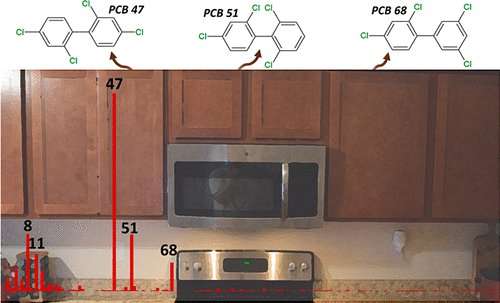Credit: American Chemical Society
Probably the last place anyone would want to find airborne polychlorinated biphenyl compounds (PCBs) is in the kitchen, yet that's exactly where scientists detected their presence, according to a new report in ACS' journal Environmental Science & Technology. They say that the PCBs, which are widely considered carcinogenic, are unwanted byproducts of sealant breakdown in modern kitchen cabinetry.
As a group, PCBs are classified by the International Agency for Research on Cancer as known human carcinogens, and their manufacture was banned in the U.S. in 1979. But because of the tendency of these chemicals to stick around in the environment and their inadvertent production as manufacturing byproducts, PCBs can still be found in offices and schools. Keri C. Hornbuckle and colleagues at the University of Iowa College of Engineering wanted to determine how much and what types of PCBs are present in and around residences.
The researchers measured the concentrations of PCBs using polyurethane-equipped passive air samplers (PUF-PAS) for a 6-week interval from August 22, 2017, to October 2, 2017, inside and outside 16 homes in Iowa. They found neurotoxic PCB-47 and PCB-51, as well as PCB-68, at much higher levels than expected. The concentrations seemed to be dependent on the year the house was built, with higher levels in more recent years. After testing the emissions coming from a variety of household items, including the stove, floor and walls, the researchers found the PCBs wafting off the finished kitchen cabinetry. The researchers suspect that the substances come from the decomposition of 2,4-dichlorobenzoyl peroxide, a common ingredient in modern cabinet sealants. This finding brings to light a previously unknown source of a toxic chemical in the home.
More information: Nicholas J. Herkert et al. Emissions of Tetrachlorobiphenyls (PCBs 47, 51, and 68) from Polymer Resin on Kitchen Cabinets as a Non-Aroclor Source to Residential Air, Environmental Science & Technology (2018). DOI: 10.1021/acs.est.8b00966
Abstract
Both Aroclor and non-Aroclor sources of airborne polychlorinated biphenyls (PCBs) were found in residential homes. We deployed passive air samplers at 16 residences and found PCB-47, PCB-51, and PCB-68 to account for up to 50% of measured indoor ΣPCBs (2700 pg m–3). Although PCB-47 and PCB-51 are neurotoxins present in Aroclor mixtures (<2.5 and <0.3 wt %, respectively), we found them at much higher levels than expected for any Aroclor source. PCB-68 is not present in Aroclor mixtures. Another non-Aroclor congener, PCB-11, a byproduct of pigment manufacturing, was found inside and outside of every household and was frequently the predominate congener. We conducted direct measurements of surface emissions and identified finished cabinetry to be a major source of PCB-47, PCB-51, and PCB-68. We hypothesize that these congeners are inadvertent byproducts of polymer sealant manufacturing and produced from the decomposition of 2,4-dichlorobenzoyl peroxide used as an initiator in free-radical polymerization of polyester resins. The presence of these three compounds in polymer products, such as silicone, has been widely noted, but to our knowledge they have never been shown to be a significant environmental source of PCBs.
Journal information: Environmental Science & Technology
Provided by American Chemical Society




















